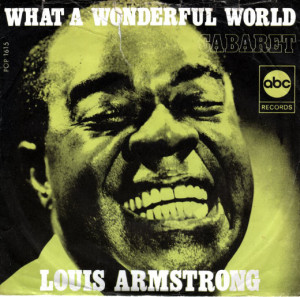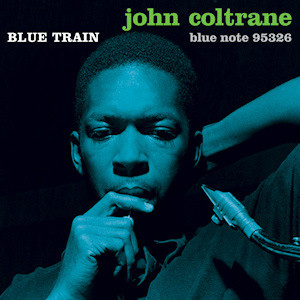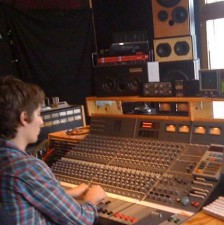Jazz in The Studio: Preserving the Sound – From Louis Armstrong to Wayne Shorter Quartet & BadBadNotGood
When you think of jazz music, Louis Armstrong is probably one of the first names that come to mind, and not because he stands among the genre’s best musicians, but because he was a crowd pleaser, a real people person. His song ”What a Wonderful World” is still considered to be one of the greatest songs ever written and sung.
In fact, jazz music was always for those who appreciated it, not just for the spotlight, glitz and glamour. As Armstrong once said, “Hot can be cool, and cool can be hot, and each can be both. But hot or cool, man, jazz is jazz.”
It’s amazing to see a genre that was so immensely influential in the 1900’s up until even the early 20th century dwindle into an almost underappreciated form of music in today’s mainstream music society.
Back then, all you heard about was jazz and classical music. In Queens, NY alone, nearly 100 of the most famous jazz musicians of all time resided, from Armstrong himself to Ella Fitzgerald, John Coltrane, Count Basie and Billie Holiday. Now it’s evolved in such a way that it really only survives in the mainstream as a partial influence for some of today’s biggest acts, or unless you seek it out at one of the few remaining jazz night clubs or a larger venue like New York’s Jazz at Lincoln Center. You do, however, probably hear it almost every day when you’re on hold on a call, or in an elevator.
With production always playing a major part in solidifying the perfect jazz recording since its earliest days, we must give credit to the studio for helping to keep such a talented and influential genre alive and kicking, and expanding. It’s become so broad of a genre, with many sub-genres, that it’s extremely hard to define.
Jazz Roots
African-American communities in the early 1900s were the source of the genre’s formation, with black musicians experimenting with ragtime, improvisation, syncopation and polyrhythms. It was essentially a fusion of traditional African slave songs and European classical music. The significance of African music again shines through, as it does in most genres today.
New Orleans was the earliest and continues to be the central hub of jazz music and prior to the foundation of jazz, traditional African dances accompanied by drums were organized within the city. African hymns, which were often heard in the church setting, were also largely responsible for the soul quality of jazz vocals. The same was for blues music, which originated around the same time as jazz.
As African-American musicians began to pick up European instruments like the violin and the Caribbean islands began to influence the genre’s roots, the basic rhythmic foundations of jazz had planted themselves.
The Structure of Jazz and Harnessing the Sound
Jazz music, like many other classic genres, is very basic at its foundation. When it first emerged, jazz used a 3-note music structure known as Tresillo, which was the basis of some of the earliest jazz compositions. There has always been significant use of the call-and-response technique, which really accounts for the life and personality of a majority of jazz tracks. It’s usually where one musician will play a distinct phrase, followed by the second musician’s phrased response. It can also mean verse and chorus, however.
Improvisation has also always been hugely responsible for separating jazz from most classical forms of music. It’s where a musician will go off on a tangent at a certain point during their performance of a song, and fabricate his or her own verse based on what they’re feeling at that very moment. It’s one of the most creative techniques, even used today by jam bands, and it can run anywhere from under a minute to sometimes close to a half hour long!
With such a focus on the raw talent of jazz musicians and the very basic instrumentation used, we must rely heavily on the studio to get us to that finished product, including the repair of low-fi live recordings and the use of creative mixing strategies.
Of course, jazz’ history is inseparable from some of the engineers and producers who dedicated their lives to recording it, such as the legendary Rudy Van Gelder. A 50+ year career saw him capture several thousand jazz sessions in his New Jersey studio for the heavyweights of the genre, including Miles Davis, Thelonious Monk, Sonny Rollins, Joe Henderson, Grant Green, Wayne Shorter, and John Coltrane, among others.
We asked Steve Wall, jazz producer, (Gretchen Parlato, Mark Guilana) what his take is on harnessing that perfect jazz sound. Steve says, “When it comes to jazz music, the listener is uniquely focused on the humanity, rather than production of the song; the personal interpretations that musicians have brought to the melody, harmony, and improvisation. We get our rush by hearing people be authentically ‘present’ with their instruments, and each other.
“From an engineering perspective, my approach when it comes to jazz music is simple,” Wall continues. “Firstly, I fix problems with the recording, often ‘rescuing’ live recordings done with a venue’s gear, who’s first priority is rightfully the PA. This is usually where I am often most creative. Tools will include EQ, multiple de-essers, multi-band compression, duplicating tracks and processing them differently, stereo-izing certain tracks, re-amping DI signals, noise-reduction plugins, sample-nudging for phase alignment, making applause sound natural even if it wasn’t recorded — steal those clean claps that bled into the overheads! cut/paste! pitch shift and make more! — cutting out individual drum hits from overhead mics to potentially sample-replace them, especially if they weren’t close-mic’d to begin with, and obviously cleaning out bad-bleed. All of this ‘rescue’ step is essential in my opinion to avoid distracting the listener.”
The next phase for Wall is more “traditional mixing.” “For example,” he says, “keeping the track compression in check, often layering them subtly, so it always sounds reasonably natural, yet controlled. Making sure solos speak, etc. Notably, I find one of the biggest contributors to overall sonic character, once the tracks are speaking well and separated, can be the reverb choice, often convolution reverb and plate. Listening is key.
“I try to tackle everything but raising the final level, which I delegate to the mastering engineer. It’s quite valuable to have a consistent-sounding board for my mixes, so I treasure my relationships with certain MEs. I look for an end product with zero harshness and smooth high-end detail to hear all of the nuances of the performance, with enough warmth to balance it out and not fatigue the ear.”
Bands like the Wayne Shorter Quartet and BadBadNotGood are just two of many bands that are currently working within the jazz spectrum. Both acts are essentially very different, with Wayne Shorter still in the classical jazz spectrum and BadBadNotGood mixing jazz with electronica, indie and R&B music, however — both bands harness what was laid forth by the talented jazz musicians before them. If you listen to some of their recorded work, you’ll notice minimal production aspects and a solid, basic foundation.
Infinity and Beyond
Jazz has shown us that despite a changing mainstream musical culture, its roots are firmly planted, and its influence continues to play a major role in new styles, genres and production techniques.
With that being said, while studios attempt to harness newer forms of jazz, it’s essential that producers and engineers alike focus less on the production and more on the passion of the artist, in a very simple method of recording. Using this less-is-more approach, studio enhancements are not always welcomed or even needed. Jazz will forever be a celebrated genre, with soul and beauty that cannot be taken away, only borrowed.
As we work on forging a future for jazz music, we can only ask ourselves…Will new artists always give credit to the artists that made this all possible way back when? Will jazz music ever push itself back into the mainstream? Will advanced production equipment and techniques rob us of the basic finished product that we currently cherish? It’s hard to say — the best thing is to keep listening, and improvising along with the genre.
– Michael Haskoor is a freelance music writer with an undying passion for music. He currently enjoys writing for Diffuser.fm, The Deli Magazine and VICE’s Noisey.com and will focus this series (done exclusively for SonicScoop) around the effect that studio production has had on different genres of music.
Please note: When you buy products through links on this page, we may earn an affiliate commission.










Stephen Hart
January 23, 2015 at 11:23 am (10 years ago)A very over the top approach to working with jazz. Simplicity is key, little or no compression, you don’t want level
out all the dynamics, Ride those faders. I cannot imagine using pitchshifting, re-amping, stereo-izing and the rest of the bag
of rock and roll and urban music tricks, Why? all you really need is good EQ, intelligent placement, great mics and a good balance.
Schtonk
January 24, 2015 at 6:26 am (10 years ago)@Stephen Hart: absolutely true. I really hate these studio nerds drowning in gimmickry and feeling like creative Gods when fumbling with all the hazardous stuff. The outcome is a superficial and brain dead soud for the deaf masses (having gotten used to 128kb/s mp3 “sound”).
Thank God there are still some record labels commited to minimal mikeing (yes, like in the 50s!!), taking care of optimal mikes & preamps and proper mike placement to preserve most of the live “vibes” (aka phase response) of the performance.
Steve
January 24, 2015 at 11:50 pm (10 years ago)Hey fellas! @Stephen Hart and @Schtonk, It’s Steve, the guy who was quoted. While I wholeheartedly agree with you on the recording approach, and am a huge listener of well thought out and beautifully simple jazz recordings, I beg you to be sympathetic to my position as a mixer. When you are handed live stems that were recorded as direct outs from a club’s mixer, from a show hastily recorded, with musicians standing 2 ft. or less away from each other, with clipping, phasing, lack of mic’s, broken mic’s, a piezo in a closed piano, a DI on an upright, and no audience mic’s, etc, there are significant challenges in the mix in order to MAKE the recording sound AS IF it was done as thoughtfully as you mention. If I handed a client a mix from those recorded lines, I’d be slapped for NOT using any gimmickry in my arsenal to make it sound beautiful. This is where I am coming from, as this is often my position, and this is why I get hired. Hand me something well recorded, and I’m happy to just ride the faders. I’m also quite happy to be a studio nerd (admittedly, “Creative God” has a nice ring to it). Either way, hope you’re well.